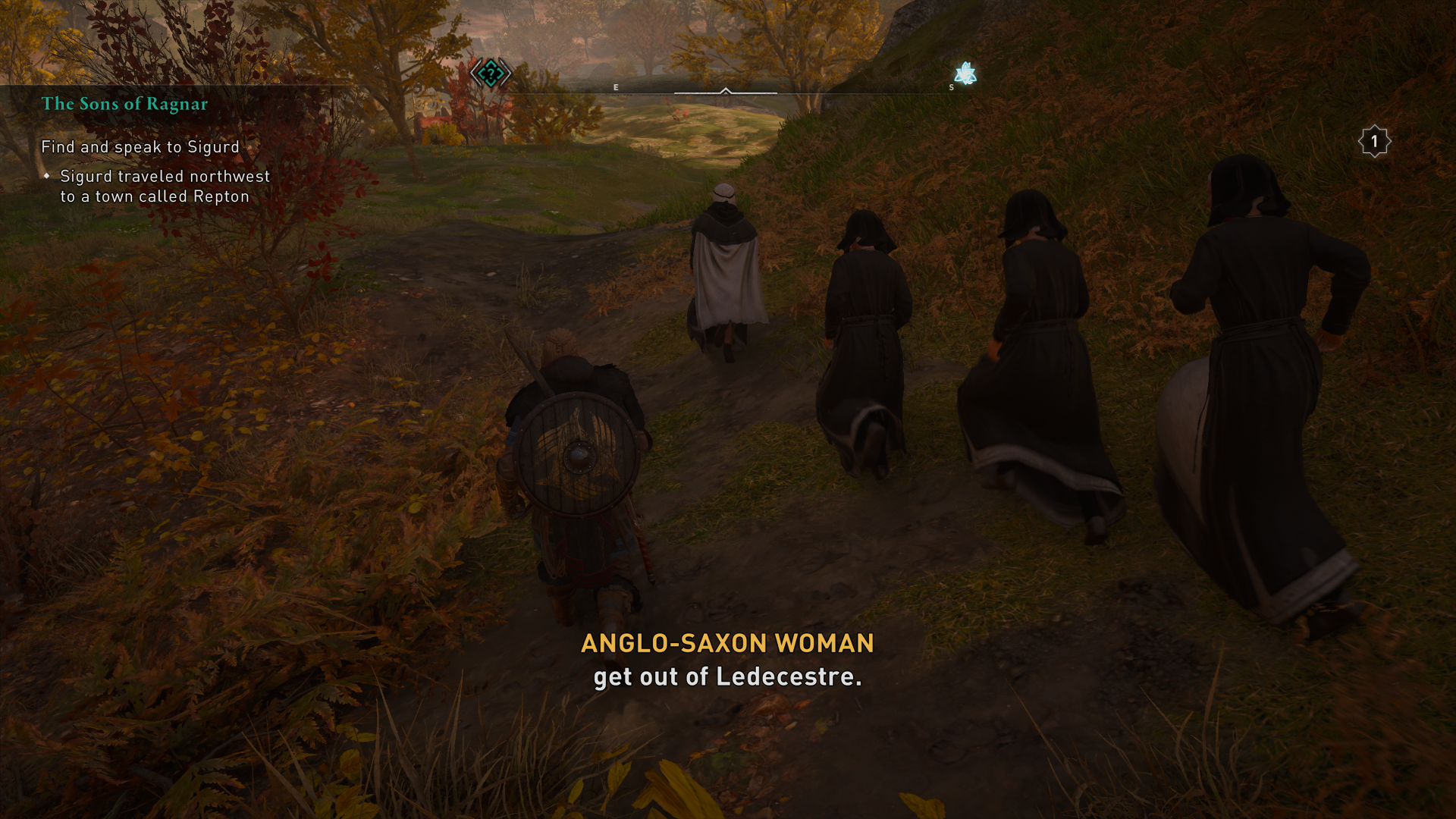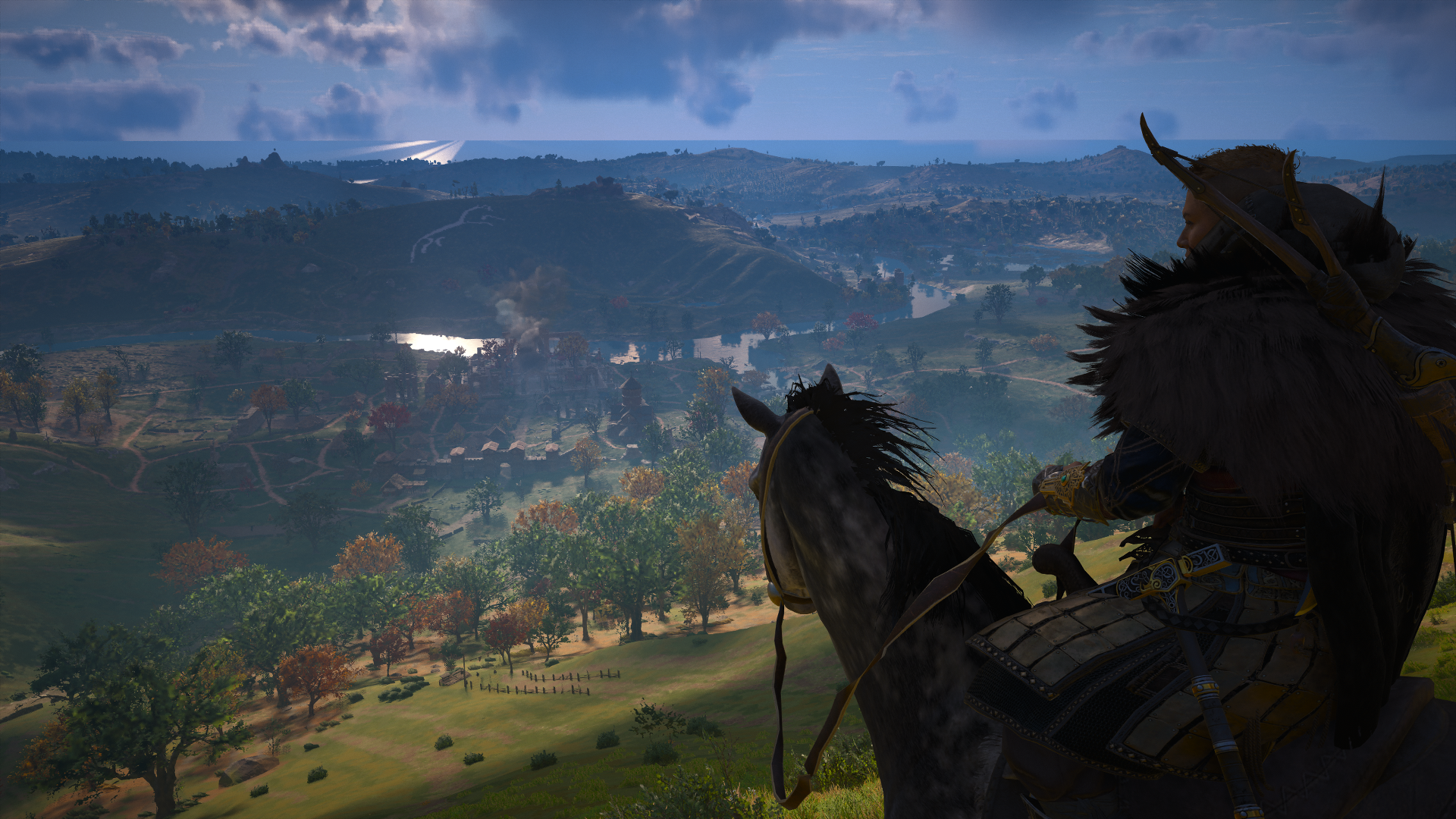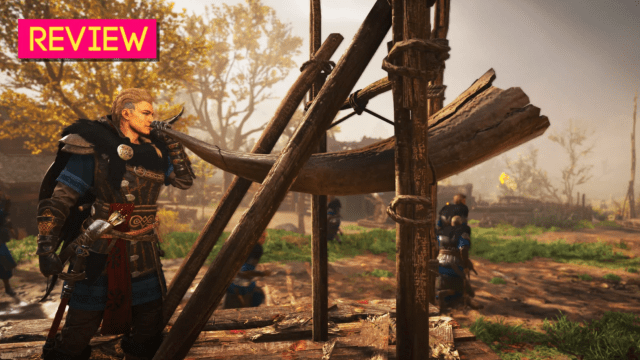Assassin’s Creed: Valhalla, a huge game made during a pandemic and with its own studio and parent company in crisis, is a game trying to do some difficult things. The first Assassin’s Creed in two years, and the 12th major Assassin’s Creed overall, it is the work of creators who are trying to honour the franchise’s past while charting its future. They’ve tried to change the formula for open-world games overall. And they’ve taken a stab at portraying the dubious morality of Viking conquest. What’s shocking is that Valhalla nearly always succeeds at these things, creating an impressive game that stands above many other contemporary open-world adventures.
Like the previous Assassin’s Creeds, Valhalla is a third-person open-world adventure featuring stealth action and lots of murder. And like those games, it features two storylines. One is set in the modern-day, including characters and narrative elements that have been around since the 2007 original. That story of Assassins fighting Templars involves ancient pre-human civilizations, secret wars between shadowy groups, and powerful artifacts of old. The other storyline — the one you spend 95% of the game playing — is set around 875 AD, when Vikings and their clans left Norway and explored and conquered parts of England and Europe.
In the modern day, you play as Layla Hassan, a researcher introduced in 2017’s Assassin’s Creed Origins who continued to star in the modern day sequences in 2018’s Assassin’s Creed Odyssey. Layla and her crew of Assassins are trying to stop the world from ending, and they’ve travelled to the final resting spot of a special Viking named Eivor. They believe that this Viking and his or her past may hold the secret to saving the modern world from disaster. To experience Eivor’s history and story, Layla enters the Animus, a device that allows people to re-live the lives of people from the past, using their DNA memories… or something. It’s just magic science mumbo-jumbo, don’t think about it too much.
Once in the Animus, you take on the role of Eivor, a Viking warrior whose parents were killed when they were young. . Eivor is raised by Styrbjorn, the clan’s king and essentially becomes siblings with the king’s son, Sigurd.
Players can choose to control a male Eivor, a female Eivor or take a third option that alternates between the two. I chose the female Eivor and didn’t really think about my choice much after that. Because the game is written to support those genders, it’s never featured in any quests or dialogue. It means Eivor is treated the same, man or woman, which is nice but also feels like a missed opportunity.
The game begins in Norway, where players first lead Eivor in a quest for revenge. Soon, the game is about politics. Eivor and Sigurd become fed up with the king and his decisions about how to rule. They recruit their friends to join them in departing Norway and sailing to England. Once in England, Eivor’s mission is to help her clan build a thriving settlement in a new world, while exploring and fighting to create allies across all of England.
This setup gives all of Valhalla a compelling, consistent sense of purpose and momentum. In not only the main narrative, but also the gameplay and progression. It gives Valhalla more structure than previous Assassin’s Creed games, which sometimes meandered for hours before finding the plot again. In Valhalla, nearly everything you do feeds into this narrative of exploring, conquering and building allies with other kingdoms.
For those who haven’t played the previous games, Valhalla should be easy to follow. While there are references to other games, the bulk of Eivor’s story is separate from the series’ meta-narrative. Only the end of the game, which I won’t spoil here, seems to expect knowledge of the franchise’s modern-day storylines, with so many cross-references that even a longtime fan like me was checking a wiki to sort it all out.
[review heading=”Assassin’s Creed: Valhalla” image=”https://www.kotaku.com.au/wp-content/uploads/sites/3/2020/11/10/u5gvciocw1nto2zfueii.jpg” label1=”BACK OF THE BOX QUOTE” description1=”A Viking’s Life For Me” label2=”TYPE OF GAME” description2=”Open-world-action-RPG-stab-a-thon” label3=”LIKED” description3=”The world, the narrative structure, big battles, gorgeous vistas” label4=”DISLIKED” description4=”Some wonky stealth gameplay, handling of Viking history” label5=”DEVELOPER” description5=”Ubisoft Montreal” label6=”RELEASE DATE” description6=”November 10″ label7=”PLATFORMS” description7=”PS4, PS5, Xbox One, Xbox Series X/S, PC, Stadia” label8=”PLAYED” description8=”66 hours” ]
Valhalla’s biggest and most interesting addition to the Assassin’s Creed formula are its Kingdoms. These are large sections of the map ruled by various kings, lords, bishops and noblemen. As Eivor, you decide which of these kingdoms to focus on. You spend a few hours talking to people there, figuring out how you can forge an alliance with this kingdom. Sometimes it involves working with the king in charge. Other times, you’ll be tasked with overthrowing a monarchy or helping a young king learn how to lead and survive his enemies. Each kingdom took me two to four hours to complete and felt like a season of a TV show. Kingdoms are separate from the main overarching plot of Valhalla, which involves Assassins, relics, secrets and powerful enemies hiding in the shadows. But they still move Eivor and your clan’s story forward. And like a good TV show, these seasons regularly end with a narrative climax that feels satisfying.
These kingdoms are where the game tries to balance who Vikings were and how brutal they could be as they invaded foreign lands. Players spend a lot of time in this game working with local communities and towns, helping them and learning from them. But you also spend a good amount of time raiding churches and fighting wars against locals and invaders. Eivor seems to understand that what is happening isn’t always fair or nice to the English who call this land home. She comments directly about this and at times shows remorse. However, she never stops expanding her clan and raiding. Ultimately, Valhalla tilts its sympathies toward the Norse fighters. They show them as courageous, but bloodthirsty warriors and invaders who are willing to burn a church down for silver. Yet they also show the compassionate side of them and emphasise many Vikings’ desire for a new life, free from oppressive kings and never-ending war. Of course, they ended up in England, a land filled with oppressive kings and never-ending wars. The more things change…
While kingdoms and their self-contained quests are the biggest and best change to the Assassin’s Creed gameplay loop, there are other changes that address shortcomings from the formula introduced with the franchise-changing Origins and its successor, Odyssey. While those games were big, open, and felt better to play, a lot of repeated side activities and quests also made them at times monotonous and repetitive.

Valhalla strips some things down and rearranges others. Side quests are very different. Gone, for the most part, are the lengthy sidequests of Origins and Odyssey that could take players on a multi-step journey through a large section of the game’s world. Instead, the map in Valhalla is filled with smaller, quicker, and more varied activities and quests to do and see. Sure, there are still random people to help out there, but their problems are often smaller and don’t involve trekking around the map. For example, on a mountainside in Norway, I found a Viking who was sleepwalking and needed me to help him back to his camp. In England, I stumbled upon some nuns who were trying to escape the country and who needed protection. One of my favourite encounters involved a Viking couple who felt their relationship was dull and boring. So they asked me to break things and start a fire in their home so they could feel the passion again, like when they were younger and fought in battles side by side. (Spoilers: It worked.)
These encounters don’t clog up your quest journal. You find them by exploring down glowing dots on your map. What you find usually only takes a few minutes and sticks to one small area of the world, like a house, a tree, a camp or a river. Because of this, I felt compelled to finish them whenever I happened to find one in the world.
In other open-world games, I would find myself avoiding some side content because it was just more hours of busywork. But in Valhalla these tiny encounters kept me playing long past my bedtime, and not because I wanted some new weapon or gear, but just because I wanted to see what new mini-story I was about to encounter.
Valhalla also deviates from some of the tedious aspects of Origins and Odyssey with its streamlined loot system. While you do find new gear and weapons in the game, it’s much more limited. You won’t be collecting thousands of bows and helmets just to sell them. Instead, there is a set amount of gear and weapons in the world, and once you find them you won’t find them again. They don’t just drop off enemies, either. Instead, they are always found at the end of quests or in specifically marked spots on the map, often involving the completion of an environmental puzzle. The key benefit of this change is you won’t spend dozens of hours fiddling with inventory management, allowing you to focus on gear you like and level it up using materials you find in the world.

Don’t be mistaken, this is a big Ubisoft game, so there is still a lot of content in the world for you to find and complete. It’s just more varied and interesting. Gone are the thousands of enemy bases and treasure chests seen in Odyssey. Instead, you have strange puzzles to solve, cursed lands to cure, and small stories to experience. The overall effect of this is that I found myself losing hours of playtime just exploring the world, curious what new thing I might find or puzzle I might discover over the next hill. It’s very easy to spend hours and hours in this game before you even realise it, and rarely did it feel like a grind.
While many fans enjoyed the previous games, some, including myself, felt the franchise was forgetting its origins and disliked that it had become less focused on stealth and assassinations. Valhalla isn’t a full return to the more classic stealth-focused Assassin’s Creed games, but it’s clear the developers wanted to bring back some of that classic action in this new game.
So, pretty quickly into Valhalla, you receive a hidden blade from a pair of Hidden Ones (a.k.a. Assassins before they called themselves that). Eivor herself isn’t an Assassin, but she does learn a few tactics from these two Assassins, including how to use the blade and how to blend in to hide in plain sight. The main tool for doing this is a hood, which players can equip when they enter cities where Vikings aren’t welcome. With this hood, you can carefully walk by enemies without them noticing you, blend in with crowds, or chill on a bench with a random civilian. These are all stealth options that have appeared in previous games, and it’s nice to see them return in Valhalla, even if it doesn’t always work. Sometimes I thought I was safe to kill someone and then the whole town was still alerted to me. Other times I would try to assassinate someone, but the game would bug out and I would be left exposed in the middle of a large crowd of angry guards. This kind of jank has always existed in Assassin’s Creed games, so if you were able to put up with it before, you should be fine. But it is worth mentioning that these issues — and issues with climbing up walls or missing jumps — are still present. They’re series staples, too, I guess.
Another returning feature in Valhalla is the ability to grow and improve your own personal settlement. This works similarly to the Villa in Assassin’s Creed II and your homestead in Assassin’s Creed III At the start of the game, the settlement is nothing more than a few tents and an old longhouse on a hill filled with bandits. As you build it up, new characters start to appear and some of them have their own stories and quests you can complete if you want to learn more about your clan. Additionally, you can unlock new features, like the ability to help the Hidden Ones take down targets, a way to customise your longship, or the ability to catch and sell fish. Most of this stuff isn’t vital to finishing the game, but it does help make your clan and their home feel more alive and personal. I built that tattoo shop. I helped create that farm. And when bad things would happen to my home or the people who lived there, I felt more invested in helping make things right or getting revenge.

The main way you build up your settlement is by completing raids. Raiding in Valhalla is all about you and your clanmates attacking and pillaging large monasteries that can be found all over the map. Each monastery has treasure and resources to plunder, though you’ll have to fight through large groups of enemies to reach it, and you’ll need help from your fellow Vikings. These raids, while fun, are another example of Ubisoft trying to walk the tightrope between portraying Vikings as invaders and settlers. For example, the game doesn’t force you to be hostile. You can actually just walk around these monasteries while wearing your hood and avoiding guards. And if you do decide to blow your Viking attack horn to start a raid, you can’t freely kill monks or innocent people who are running for their lives. Doing so will cause you to fail the raid. Even if you spare the innocents and only attack churches, you are still burning homes and churches to the ground and stealing their stuff. The main excuse the game provides is that the monasteries are run by corrupt bastards. It’s historically accurate that Vikings raided, but for those not comfortable living out the fantasy of being a colonising invader, raids will most likely leave a sour taste in your mouth. For me, it left me with mixed feelings about Eivor and her clan. I still liked them and cared about what happened to them, but I couldn’t shake this nagging feeling in the back of my mind while they laughed and cried, that they also murdered and pillaged.
After over 60+ hours of playing Assassin’s Creed: Valhalla, I was surprised by how well it was able to innovate while bringing back classic elements, like social stealth and settlement development. I wish there was a bit more sneaky-sneaky action here, but was glad to at least see an increase from recent games. Valhalla also does a good job portraying the Vikings as deadly invaders and lost settlers looking for a new life.
The changes Valhalla brings to the franchise feel as great as a warm hearthfire during a cold winter night. The game’s developers have crafted a world that is wonderful to explore, that soaked up hours and hours of my day before I noticed It. The changes to how the game handles loot and questing, for example, make it a nicer experience to play. Overall, it feels a lot of care and thought went into making Valahalla feel less like a checklist of things to do and more like a world to organically experience.
This might not be what longtime fans who miss the more stealth-oriented games wanted, but for those looking for a big, open-world that isn’t boring, there aren’t much better than Valhalla.

Leave a Reply